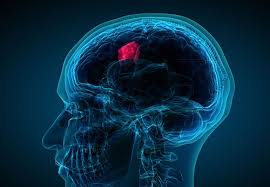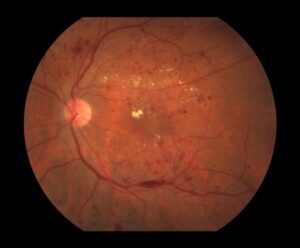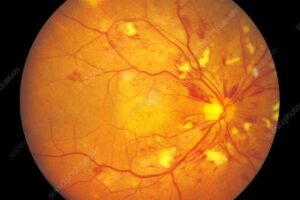Your eyes truly are windows to the live action of blood vessels, nerves and connective tissues throughout your body. Certain health signs can be spotted in the eye and are often the first signs of disease lurking elsewhere in the body. At EyeQ Vision our skilled optometrists run a complete eye exam on each of our patients using the Optos Retinal Imaging and recommended dilation, as well as the Zeiss OCT evaluation for higher risk or symptomatic patients.
Here are 20 surprising conditions your EyeQ Vision eye doctor may detect during a comprehensive eye exam:
An aneurysm is a bubble in the wall of a blood vessel. This weak wall can leak or rupture. Signs of an aneurysm can include a severe, one-sided headache or loss of facial or body function. Aneurysms can be catastrophic and require immediate medical attention.

Tumors can cause increased pressure in the brain that gets transmitted to the eye. Swelling near the back of the eyes causes changes to the optic nerve that an eye doctor can see. Loss of side vision, recent double vision or changes in the size of a pupil are other signs of a brain tumor.
Numerous cancers can be found during a detailed eye exam. Skin cancers affect the eyelids and outer surfaces of the eye. The most common types of skin cancers are basal cell, squamous cell and melanoma. Leukemia and lymphoma can also affect the interior aspect of the eye. Tumors in the breast and other areas can spread to the ocular structures.

Tiny blood vessels in the retina that leak yellow fluid or blood can be a sign of diabetic retinopathy. Sometimes, this disease appears in eye tissue even before a person has been diagnosed with diabetes. Early detection can help people avoid vision loss and other serious complications.
Giant cell arteritis (GCA) is a lingering inflammation of medium-sized arteries that affects the arms, upper body and neck. These same arteries help nourish the eyes, and inflammation can result in blurred vision, double vision, or even sudden vision loss in one or both eyes. A dilated eye exam and blood tests for this condition can allow for an early diagnosis of GCA. Medical treatment can prevent a lifetime of blindness or even early death.
Eye doctors may be able to detect early signs of heart disease in the eyes. When the retina is examined carefully using an imaging tool called optical coherence tomography (OCT), doctors may be able to detect microscopic marks left behind by an eye stroke. These marks can appear in the retinas of healthy people, but they’re found in higher numbers in people with heart disease.

Unusual bending, kinks or blood leaking from blood vessels in the back inside wall of the eye can signal high blood pressure. High blood pressure affects one in three American adults. High blood pressure is a known risk factor in the onset and/or progression of certain eye diseases such as glaucoma, diabetic retinopathy, macular degeneration and other diseases. Your doctor may notice signs of high blood pressure during a dilated eye exam and recommend further evaluation by your PCP or specialist.
A mild yellow or blue ring around the cornea in the front part of the eye, may be a sign of high cholesterol, especially in a person younger than age 40. Deposits in the blood vessels of the retina can also indicate elevated cholesterol. This may be the precursor to a life-threatening stroke as the cholesterol can dislodge and move to other parts of the body and brain.
This chronic inflammatory disease can coincide with dry eyes. Lupus can also cause swelling in the white part of the eye, the middle layer of the eye or the light-sensitive tissue in the back of the eye. Patients on common Lupus medications such as Plaquenil require regular thorough retinal evaluation each year as part of proper care and management.
Lyme disease is an infection spread by ticks, which leads to inflammation throughout the body. Many people with Lyme disease may experience inflammation of the optic nerve as well as an increase in floaters at the onset of infection.
Several prescription and over the counter drugs may be toxic to the retina and the optic nerve. Symptoms of toxicity include red, scaling eyelids, red eyes, scratchy corneas or conjunctivitis.
Inflammation of the delicate optic nerve can be a harbinger of multiple sclerosis, a degenerative neurological disease. Often, this inflammation goes hand-in-hand with a new onset of severely blurred vision, painful eye movement or even double vision.

Myasthenia gravis is an chronic autoimmune disorder that causes muscles to weaken and tire easily. The first symptoms of this condition often involve the eyes. The most common sign of the disease can be drooping eyelids in one or both eyes. Other symptoms may include double vision, weakness in the arms or legs, or problems with breathing, talking, chewing or swallowing.
Ocular signs of rheumatoid arthritis (RA) most commonly include red eyes with deep, severe pain. This symptom can signal scleritis, a painful inflammation of the white part of the eye which requires medical therapy. Many people who have RA also suffer from dry eyes.
This inflammatory disease affects multiple organs in the body, including the lungs and eyes. The most common eye symptom of this disease is iritis, a recurring, painful inflammation of the iris or colored part of the eye. This condition also causes severe light sensitivity.

Syphilis, herpes, chlamydia, HIV, and gonorrhea can all affect layers of the eye. These serious conditions are often detected during an eye exam.
People with sickle cell disease, a genetic blood disorder, develop stiff, comma-shaped red blood cells that can block the flow of blood throughout the body. This disease can cause a huge spectrum of ocular changes, from redness and burst blood vessels on the surface of the eye to severe hemorrhages and even retinal detachment inside the eye.

This autoimmune disease causes the body’s white blood cells to attack the glands that make tears and saliva. Unsurprisingly, dry eyes are a key feature of Sjögren’s syndrome. Other symptoms include burning or stinging in the eyes, blurry vision and dry mouth. Management of severe dry eye syndrome is essential for good ocular health and clear long term vision.

Blood vessels of the retina sometimes reveal microscopic vascular blockages or clots. These blockages can cause sudden blind spots or give the sense of a “curtain” closing over a person’s vision. These can point to an increased risk for stroke. A loss of peripheral vision may also be a warning of brain damage caused by a previous stroke.
Protruding eyeballs appearance and retracting eyelids are telltale signs of hyperthyroidism, most commonly caused by an autoimmune disease called Graves’ Disease. This happens when the thyroid gland produces too much or too little hormone. Sometimes this also coincides with severe dry eye, blurry vision or vision loss.
Clotting disorders and bleeding disorders may cause visible bleeding in and around the eye. These surface bleeding are known as subconjunctival hemorrhages. These blood thinning disorders can also cause retinal hemorrhages that threaten vision.
Dry eyes and night blindness are both signs of Vitamin A deficiency. Without enough vitamin A, your eyes cannot produce enough moisture to keep them properly lubricated. Low levels of vitamin A also lead to night blindness, by preventing production of visual pigments needed for your retina to work properly. Vitamin A deficiency is the leading cause of preventable blindness in children worldwide.
It’s important to remember that these ocular signs don’t guarantee you have a certain health condition. They are a visual starting point to direct you and your doctors in search of a medical condition that can be life threatening. Whenever an eye exam reveals a possible health problem, your optometrist will recommend further testing by the proper specialist or your primary care provider to ensure your continued healthy vision and life.
The American Academy of Optometry recommends that all adults and children get a complete eye examination yearly. Typically after the age of 40 is when early signs of disease or changes in vision may first appear.


